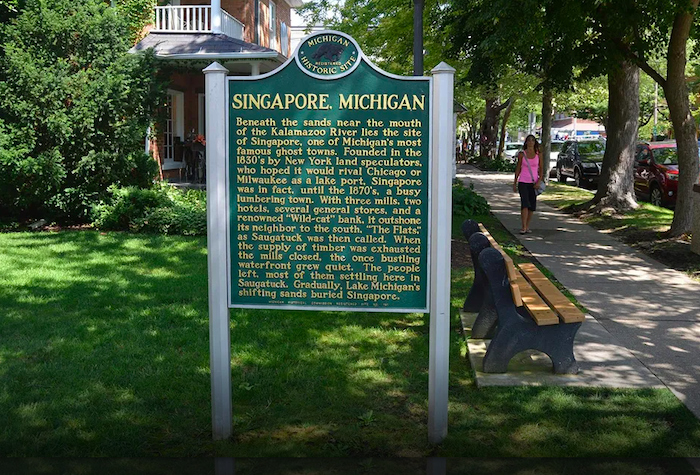Deputy Prime Minister and Finance Minister Lawrence Wong knows how vulnerable Singapore is. He has also seen Singapore reduced to a ghost town in America.
“We know that it is very easy for small cities like us to fail. I had a very vivid reminder of this when I was a student at Michigan,” he said, speaking at the American Chamber of Commerce’s 50th anniversary celebrations in Singapore on September 1. “Some of you may know, there is a ghost town in Michigan, called Singapore.”
That’s right. Soon after Raffles landed in Singapore in 1819, another Singapore came up in America. By the 1830s, Singapore was commercially important enough for President Andrew Jackson to appoint Joseph Balestier as the first American consul in Singapore. Balestier Road in central Singapore is named after him.
Singapore, Michigan
While the Balestier family took up residence in Singapore, another Singapore was forming on the shores of Lake Michigan in America. New York land speculator Oshea Wilder moved to Michigan as a pioneer taming the wilderness and bought land on the shores of Lake Michigan, where he founded the village of Singapore in 1836. He hoped to build a port town to rival Chicago and Milwaukee.
The town could make a living felling the trees in the surrounding forests, cutting the logs into lumber at lumber mills and shipping the lumber across the lake to Chicago, Milwaukee and other towns and cities. At its peak, the town had several mills, two hotels, a number of stores, and a bank called the Bank of Singapore, which issued its own currency notes.


Making a good living out of timber, the town also ventured into shipbuilding, building steamships and schooners.
Singapore was lucky. When the great fires swept through the Midwest, ravaging Chicago in Illinois, Port Huron and Holland in Michigan and Peshtigo in Wisconsin in 1871, Singapore was spared.
The town prospered, supplying timber and other construction materials to rebuild Chicago and other fire-ravaged towns and cities.
But by 1875, Singapore had run out of timber. With no more trees, there were no more jobs in Singapore. People moved away.
Singapore became a ghost town unprotected from the elements. There was soil erosion — and no vegetation to act as a barricade against the shifting sands. By the end of the 19th century, Lake Michigan’s shifting sands had buried Singapore.
As Deputy Prime Minister Lawrence Wong told the American Chamber of Commerce, “The shifting sand dunes around Lake Michigan swallowed up the ghost town. So the only marker of its existence today is just a signboard.”
Singapore Yacht Club


There’s also the Singapore Yacht Club, located in the nearby town of Saugatuck. Michigan’s Newsradio 950 WWJ reported on July 15, 2023:
“While ‘Singapore’ still lives on in name as the ‘Singapore Yacht Club’ which was only established in 1959, four buildings from the town were spared and moved to Saugatuck before the sand buried them. The buildings include the bank and three houses, which were transported down the frozen Kalamazoo River on logs in the winter.
“The Singapore Bank building has been converted into a book store and art gallery,” the report added.
“So, Singapore in Michigan did not last very long,” said Mr Lawrence Wong, speaking to the American Chamber of Commerce.
“Singapore in Southeast Asia has been around for some time; we have been independent for nearly 60 years and we are determined to keep going for a very long time,” he added.
“But we can do this only through strong partnerships and that is why we value the partnership that we have with the US.”
Today, Singapore is the US’ largest trading partner in Southeast Asia, said Mr Wong. “America continues to be our largest foreign investor here. And we host more than 5,700 American companies, with many of you playing a leading role in your respective industries.”

